Simple View of Reading (Gough and Tunmer, 1986)
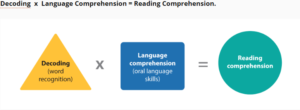
The Simple View of Reading by Gough and Tunmer (1986) is a formula that demonstrated, the now widely accepted view, that reading has two basic components: word recognition (decoding) and language comprehension.
The Simple View formula, WR X LC = RC, has been supported and validated by numerous research studies. It has “…proven to be highly predictive of individual differences in reading ability with a 95-99% level of accuracy that is almost unheard of in social scientific research and which has a profound influence on both instruction and intervention” (J. Buckingham, 2020).
Understanding this formula helps educators when assessing reading weaknesses and providing appropriate instruction.

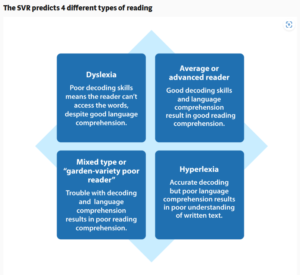  (All 3 models are based on the findings of, Gough and Tunmer.1986)
 (All 3 models are based on the findings of, Gough and Tunmer.1986)
As we have previously learnt, learning to read is not the same as learning to talk. Our brains are wired to learn to speak by being exposed to language – not the same for reading.
You can be a good decoder, but if you do not comprehend language, you won’t be able to understand what you’re reading.
Or, the opposite, you can have excellent listening comprehension skills, but cannot decode words, your brain power is being used to decode, and you miss the meaning.
BOTH are essential to read!
Let’s watch a short video explaining this formula further.
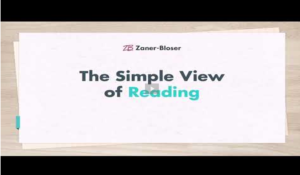
The Science of Reading Basics, Part 2: The Simple View of Reading – YouTube
https://www.researchgate.net/publication/225973881_The_Simple_View_of_Reading Zan’s and Bloser (1.53min)
Now listen to Linda Farrell (M Ed) explain the importance of the Simple View of Reading and how it can be used to inform teaching and intervention.
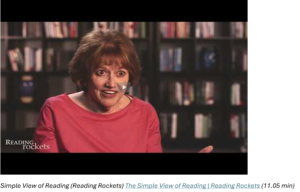
Simple View of Reading (Reading Rockets) The Simple View of Reading | Reading Rockets (11.05 min)
Further links for your reference
Qld Dept Of ED – Reading and Writing Centre https://readingwritingcentre.education.qld.gov.au/reading-writing-disorders/Documents/simple-view-of-reading-infographic.pdf
The Simple View of Reading | Reading Rockets
simple-view-of-reading-and-year-1-phonics-check.pdf (Literacy Hub, 2023))
Models of Reading | Reading Rockets
The Simple View of Reading (SVR)-Part 1 – Orton Gillingham Online Academy
Pattan Snippet – Simple View of Reading
The Simple View of Reading – YouTube

What is the “Simple View of Reading?” What it Means for Meaning-Making
Dr Maria Murray – The Reading League (18.31 min)
What is the “Simple View of Reading?” What it Means for Meaning-Making – YouTube
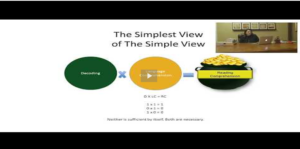
Scarborough’s Reading Rope (Scarborough, 2001)
The Many Strands That Are Woven into Skilled Readers
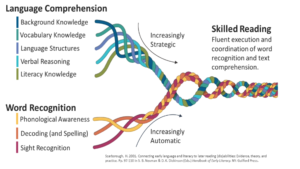
Dr Hollis Scarborough, creator of the famous Reading Rope is an American psychologist and literacy expert who is a senior scientist at Haskins Laboratories. She is a leading researcher of early language development and its connection to later literacy.
Scarborough’s rope model fleshes out the Simple view of Reading by illustrating how the Word Recognition and Language Comprehension sub skills are combined as skilled reading is accomplished.
The genesis of the Reading Rope dates back to Scarborough’s lectures for parents on the complexities involved in learning to read. Originally, she 0spoke of skilled reading as resembling the “strands” of a rope, using pipe cleaners to illustrate the interconnectedness and interdependence of all the components.
The Reading Rope consists of lower and upper strands.
The word-recognition strands (phonological awareness, decoding, and sight recognition of familiar words) work together as the reader becomes accurate, fluent, and increasingly automatic with repetition and practice.
Concurrently, the language-comprehension strands (background knowledge, vocabulary, language structures, verbal reasoning, and literacy knowledge) reinforce one another and then weave together with the word-recognition strands to produce a skilled reader.
This does not happen overnight; it requires instruction and frequent practice over time.
Here a key question emerges: What should be emphasized instructionally?
For readers to be able to navigate their way through a text and utilize language comprehension strategies, a level of automaticity or proficiency in word recognition needs to be secured.
Therefore, the goal is to develop a strong stable neural system early on, through explicit instruction, to allow for instant retrieval of words; or in other words, to access words from memory by sight.
Remember, sight word recognition is not limited to high frequency or difficult to decode words; this simply refers to the automatic retrieval of words without conscious attention. When this occurs, it allows the shift in the cognitive load allowing the brain to focus on constructing meaning.
Let’s watch this short video explaining this framework further.
The Science of Reading Basics, Part 3: Scarborough’s Reading Rope – YouTube
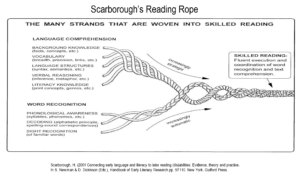
Scarborough, H. S. (2001). Connecting early language and literacy to later reading (dis)abilities: Evidence, theory, and practice. In S. Neuman & D. Dickinson (Eds.), Handbook for research in early literacy (pp. 97–110). New York, NY: Guilford Press.
Further links for your reference
handbookearlylit.pdf Scarborough, H. S. (2001). Connecting Early Language and Literacy to Later Reading (Dis)Abilities: Evidence, Theory, and Practice. In S. Neuman & D. Dickinson (Eds.), Handbook for research in
early literacy. New York: Guilford Press.
The reading League COMPASS – SVR & Reading Rope.pdf
Comprehension – Five from Five
